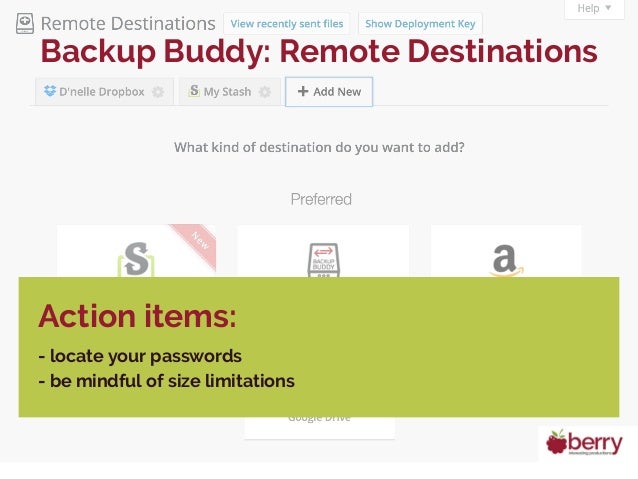


Storing and Automating your Backupsīy default, BackupBuddy will store your backups on your local server, where WordPress is installed.
WORDPRESS BACKUP BUDDY FULL
You also might want to send a lean version of your backup to one remote location, and your full backup somewhere else. You probably have a good reason to backup your database, which changes rapidly, on a more regular basis then you do the rest of your site, which is less likely to change. Why set up multiple profiles? There are a few reasons. Most of the settings in this section can be overridden on an individual basis, but it is good to go through them and make sure everything is set correctly.īasic settings, specify which files to exclude
WORDPRESS BACKUP BUDDY PASSWORD
For instance, you can set an ImportBuddy password (which I’ll go over in a bit), which will be used by default. To access these you can go to BackupBuddy -> Settings where you will see some details about specific backups, as well as some basic configuration options. Of course, you can also create your own custom profile, by clicking the plus icon, specifying your backup and choosing your settings.Īll of these settings, by the way, have global defaults. And for each profile, you can set up a default location, local or remote, to store the backup. For full backups, you can even choose exactly which files and database columns the plugin should pay attention to. The gear icon next to each one of your profiles will take you to a modal box where you can set up exactly what is you want to backup. But the real strength of the plugin is that these profiles can be customized. Clicking on either one of these profiles will begin a backup manually, right away. One is for your full site, meaning your site files and database, and the other is for just your database. One of the first things you’ll notice if you go to BackupBuddy -> Backups in the WordPress admin, is that there are two backup profiles already set up for you. But there is also a lot more than you can customize if you choose to dive into the plugin. If you’re looking for the path of least resistance, that’s the easiest way to go. Basically, if you enter your email, a unique password, a schedule, and set up a remote location, you can get your first backup off the ground very quickly. The first time you activate BackupBuddy, you will notice that you are taken to their Backup Wizard.


 0 kommentar(er)
0 kommentar(er)
